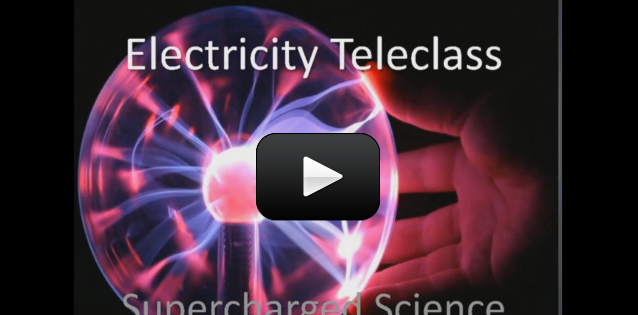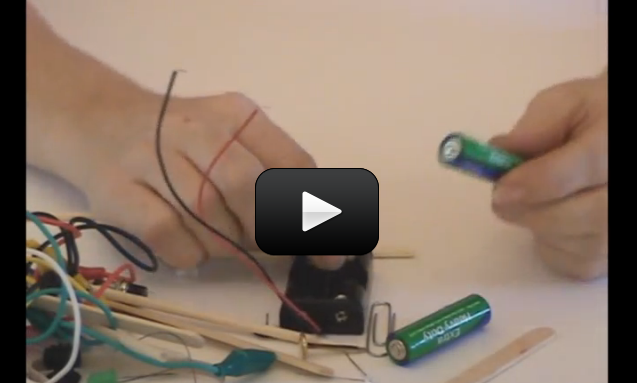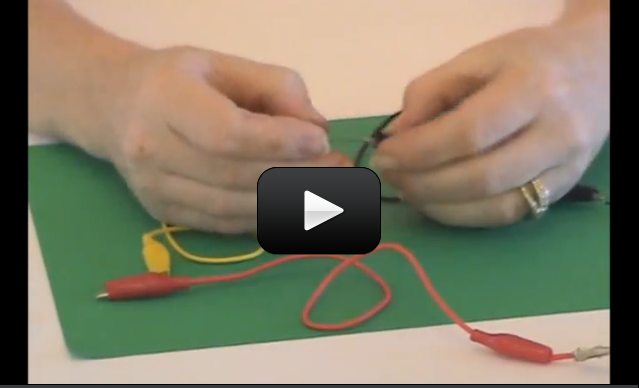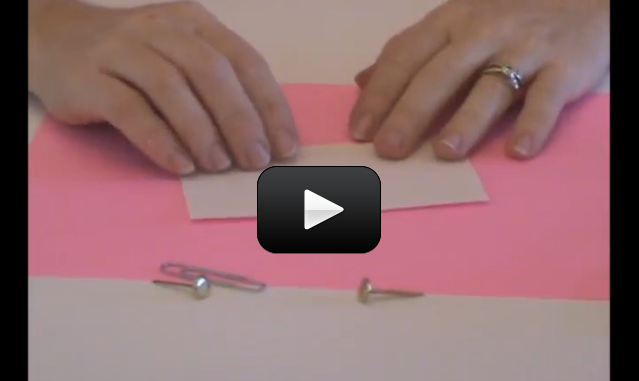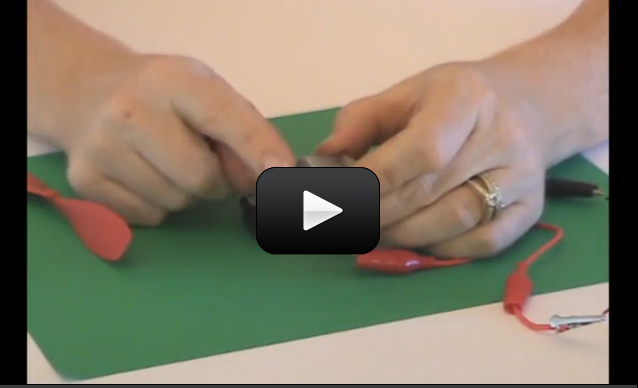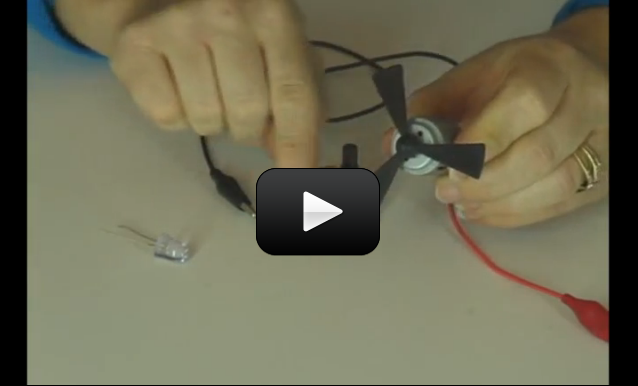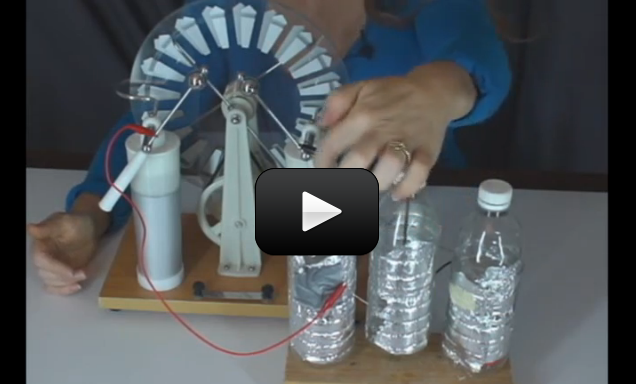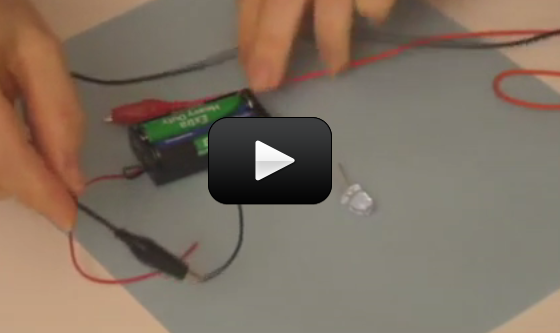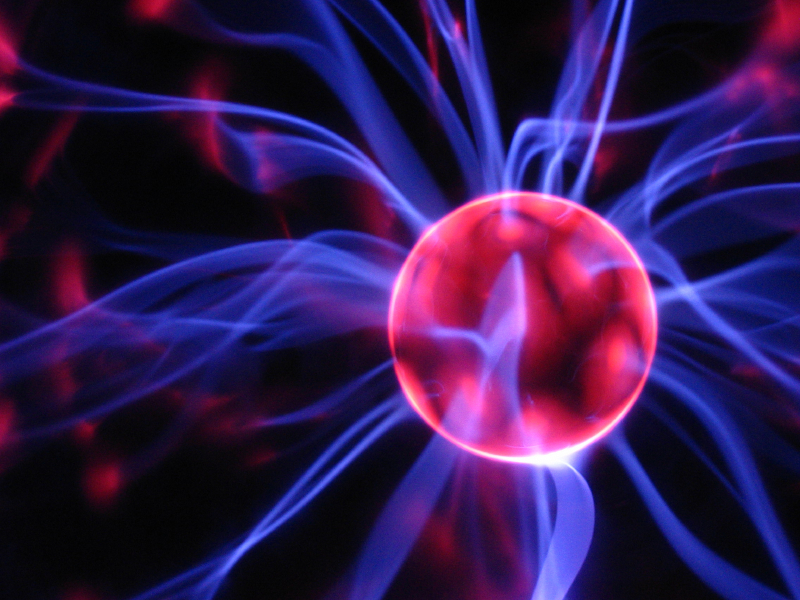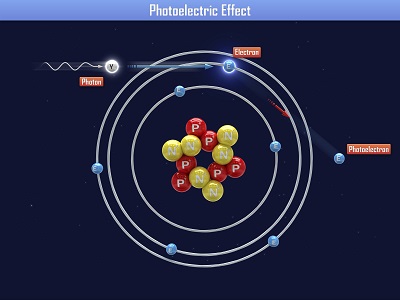 Einstein received a Nobel Prize for figuring out what happens when you shine blue light on a sheet of metal. When he aimed a blue light on a metal plate, electrons shot off the surface. (Metals have electrons which are free to move around, which is why metals are electrically conductive. More on this in Unit 10).
Einstein received a Nobel Prize for figuring out what happens when you shine blue light on a sheet of metal. When he aimed a blue light on a metal plate, electrons shot off the surface. (Metals have electrons which are free to move around, which is why metals are electrically conductive. More on this in Unit 10).
When Einstein aimed a red light at the metal sheet, nothing happened. Even when he cranked the intensity (brightness) of the red light, still nothing happened. So it was the energy of the light (wavelength), not the number of photons (intensity) that made the electrons eject from the plate. This is called the ‘photoelectric effect’. Can you imagine what happens if we aim a UV light (which has even more energy than blue light) at the plate?
This photoelectric effect is used by all sorts of things today, including solar cells, electronic components, older types of television screens, video camera detectors, and night-vision goggles.
This photoelectric effect also causes the outer shell of orbiting spacecraft to develop an electric charge, which can wreck havoc on its internal computer systems.
A surprising find was back in the 1960s, when scientists discovered that moon dust levitated through the photoelectric effect. Sunlight hit the lunar dust, which became (slightly) electrically charged, and the dust would then lift up off the surface in thin, thread-like fountains of particles up ¾ of a mile high.
[am4show have=’p8;p9;p97;p58;’ guest_error=’Guest error message’ user_error=’User error message’ ]
Materials:
- soda or steel can
- paper clip
- sand paper
- tinsel (or aluminum foil and scissors)
- tape
- foam cup
- PVC pipe (any size)
- brown paper bag
- UV shortwave lamp (sometimes called a “germ-free portable lamp”)
[/am4show]
This is a recording of a recent live teleclass I did with thousands of kids from all over the world. I’ve included it here so you can participate and learn, too!
We’re going to study electrons and static charge. Kids will build simple electrostatic motor to help them understand how like charges repel and opposites attract. After you’ve completed this teleclass, be sure to hop on over the teleclass in Robotics!
Electrons are strange and unusual little fellows. Strange things happen when too many or too few of the little fellows get together. Some things may be attracted to other things or some things may push other things away. Occasionally you may see a spark of light and sound. The light and sound may be quite small or may be as large as a bolt of lightning. When electrons gather, strange things happen. Those strange things are static electricity.
[am4show have=’p8;p9;p11;p38;p76;p20;p47;p97;p58;’ guest_error=’Guest error message’ user_error=’User error message’ ]
Materials:
- Balloon (7-9″, inflated with air, not helium)
- AA battery case
- 2 AA batteries for your battery case (cheap dollar-store “heavy duty” type are perfect. Don’t use alkaline batteries if you can help it, because kids are going to short circuit their circuits, and the cheaper kind are safer in case they do.)
- 1-2 LEDs
- Alligator wires
- 1.5-3V DC motor
- 3-6V buzzer
If you want to make the laser burglar alarm, then get these also:
- OPTIONAL: CdS Photoresistor for the laser burglar alarm
- OPTIONAL: 9V Battery for laser burglar alarm
- OPTIONAL: Laser pointer (the cheap kind from the dollar store work great) or strong flashlight for the laser burglar alarm
If you want to make the first robotics projects then also get these:
- OPTIONAL: block of foam (any kind will do that is at least 2″ on each side)
- OPTIONAL: 10 (or more) wood skewers at least 4″ long
- OPTIONAL: 1 wood clothespin
- OPTIONAL: Hot glue and glue sticks (with adult help)
If you want to make the second robotics project then also get these:
- OPTIONAL: Additional 3V DV motor (you need two for this project)
- OPTIONAL: 6 large popsicle sticks (tongue depressor size)
- OPTIONAL: Tack or other sharp object for poking holes
- OPTIONAL: Hot glue and glue sticks (with adult help)
Key Concepts
The proton has a positive charge, the neutron has no charge (neutron, neutral get it?) and the electron has a negative charge. These charges repel and attract one another kind of like magnets repel or attract. Like charges repel (push away) one another and unlike charges attract one another. Generally things are neutrally charged. They aren’t very positive or negative, rather have a balance of both.
Things get charged when electrons move. Electrons are negatively charged particles. So if an object has more electrons than it usually does, that object would have a negative charge. If an object has less electrons than protons (positive charges), it would have a positive charge. How do electrons move? It turns out that electrons can be kind of loosey goosey.
Depending on the type of atom they are a part of, they are quite willing to jump ship and go somewhere else. The way to get them to jump ship is to rub things together. Like in our experiment we’re about to do…
What’s Going On?
In static electricity, electrons are negatively charged and they can move from one object to another. This movement of electrons can create a positive charge (if something has too few electrons) or a negative charge (if something has too many electrons). It turns out that electrons will also move around inside an object without necessarily leaving the object. When this happens the object is said to have a temporary charge.
When you rub a balloon on your head, the balloon is now filled up with extra electrons, and now has a negative charge. Opposite charges attract right? So, is the entire yardstick now an opposite charge from the balloon? No. In fact, the yardstick is not charged at all. It is neutral. So why did the balloon attract it?
The balloon is negatively charged. It created a temporary positive charge when it got close to the yardstick. As the balloon gets closer to the yardstick, it repels the electrons in the yardstick. The negatively charged electrons in the yardstick are repelled from the negatively charged electrons in the balloon.
Since the electrons are repelled, what is left behind? Positive charges. The section of yardstick that has had its electrons repelled is now left positively charged. The negatively charged balloon will now be attracted to the positively charged yardstick. The yardstick is temporarily charged because once you move the balloon away, the electrons will go back to where they were and there will no longer be a charge on that part of the yardstick.
This is why plastic wrap, Styrofoam packing popcorn, and socks right out of the dryer stick to things. All those things have charges and can create temporary charges on things they get close to.
Questions to Ask
- Does the shape of the balloon matter? Does hair color matter?
- What happens if you rub the balloon on other things, like a wool sweater?
- If you position other people with charged balloons around the table, can you keep the yardstick going?
- Can we see electrons?
- How do you get rid of extra electrons?
- Rub a balloon on your head, and then lift it up about 5 inches. Why is the hair attracted to the balloon?
- Why does the hair continue to stand on end after the balloon is taken away?
- Why do you think the yardstick moved?
- What other things are attracted or repelled the same way by the balloon? (Hint: try a ping pong ball.)
[/am4show]
If you have a Fun Fly Stick, then pull it out and watch the video below. If not, don’t worry – you can do most of these experiments with a charged balloon (one that you’ve rubbed on your hair). Let’ play with a more static electricity experiments, including making things move, roll, spin, chime, light up, wiggle and more using static electricity!
[am4show have=’p8;p9;p97;p58;’ guest_error=’Guest error message’ user_error=’User error message’ ]
Materials:
- sheet of paper
- two empty, clean soup cans
- aluminum foil
- long straight pin
- three film canisters (or M&M containers)
- penny
- sheet of paper
- neon bulb
- small styrofoam ball
- fishing line or thread
- chopstick
- foam cup
- dozen small aluminum pie tins
- hot glue with glue sticks
- Fun Fly Stick (also called “Wonder Fly Stick”)
This video show you how to get the most out of your Fun Fly Stick. If you don’t have a Fly Stick, simply use an inflated balloon that you’ve rubbed on your head. In the video, the Electrostatic Lab is mounted on a foam meat tray I found at the grocery store.
Download Student Worksheet & Exercises
The triboelectric series is a list that ranks different materials according to how they lose or gain electrons. Near the top of the list are materials that take on a positive charge, such as air, human skin, glass, rabbit fur, human hair, wool, silk, and aluminum. Near the bottom of the list are materials that take on a negative charge, such as amber, rubber balloons, copper, brass, gold, cellophane tape, Teflon, and silicone rubber.
When you turn on your Fun Fly Stick (or rub your head with a balloon), one end of the Fun Fly Stick takes on a positive charge and the other end holds the negative charge. When you rub your head with a balloon, the hair takes on a positive charge and the balloon takes on a negative charge.
When you scuff along the carpet, you build up a static charge (of electrons). Your socks insulate you from the ground, and the electrons can’t cross your sock-barrier and zip back into the ground. When you touch someone (or something grounded, like a metal faucet), the electrons jump from you and complete the circuit, sending the electrons from you to them (or it).
Exercises
- What is common throughout all these experiments that make them work?
- What makes the neon bulb light up? What else would work besides a neon bulb?
- Does it matter how far apart the soup cans are?
- Why does the foil ball go back and forth between the two cans?
- Why do the pans take on the same charge as the Fly Stick?
- When sticking a sheet of paper to the wall, does it matter how long you charge the paper for?
- Draw a diagram to explain how the electrostatic motor works. Label each part and show where the charges are and how they make the rotor turn.
[/am4show]
How many of these items do you already have? We’ve tried to keep it simple for you by making the majority of the items things most people have within reach (both physically and budget-wise).
You do not need to do ALL the experiments – just pick the ones you want to do! Look over the experiments and note which items are needed, and off you go!
Click here for a printer-friendly version of this page.
We’re going to reuse some of the materials listed here that are more expensive, like the motors, batteries, wires, switches, lights, etc. in the Laser Lab and the Robot Lab, so you can get a couple extras if you don’t want to tear apart your projects after you’ve built them.
Note to e-Science students: These materials are from Unit 10.
Materials
- Regular sized latex balloon
- Ping pong ball
- Bubble solution (make your own with 1 cup clear Ivory dish soap + 12 cups cold water)
- Yard stick (AKA meter stick)
- Soup spoon (bigger is better)
- 3 large paper clips
- 8 brass fasteners
- 2 index cards or scraps of cardboard
- AA battery pack
- LEDs
- 3VDC motor
- 10 alligator clip leads
- SPST push-button switch
- 1K potentiometers
- Metal jewelry
- AA batteries for your battery case (Cheap dollar-store “heavy duty” type are perfect. Do NOT use alkaline batteries like Duracell or Energizer!)
- Optional: Buzzer (Jameco 24872)
Tools
- Tape
- Scissors
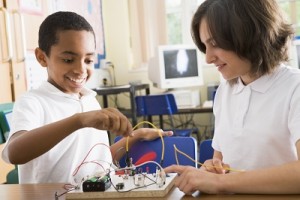 Click here for a printer-friendly version of this page.
Click here for a printer-friendly version of this page.
Objective You’re going to take a deeper look at the atom by stripping off part of it called the electron and messing around with it to make things move, stick, jump, and have bad hairdos. This is an excellent time to hone their observation skills and get them into the habit of changing and testing only one thing at a time.
Main Ideas While the kids are playing with the experiments see if you can get them to notice these important ideas. When they can explain these concepts back to you (in their own words or with demonstrations), you’ll know that they’ve mastered the lesson.
- Opposite charges attract, like charges repel.
- Electrons cannot be seen, but they are very small particles that are easy to move around.
About the Experiments The experiments in this section are mostly the same ones found in Unit 10, for two reasons. First, these are the activities we do when we teach Science Camp Workshops during the summer, and we’ve added live video from these workshops so you can see us in action. Second, have you seen how massive Unit 10 is? We took the feedback we received to heart and now we’ve made Unit 10 a lot more doable by chunking the experiments down into three main categories and minimized the academics so you can focus on getting your kids excited just by doing the coolest experiments from the section.
Electricity experiments can be frustrating because unlike other activities, you can’t tell where you’re going wrong if the circuit doesn’t work. Here are the things we test for when troubleshooting a circuit with the students:
- Are the batteries in right? (Flat side goes to the spring.)
- Is the connection between the alligator clip and the wire a metal-to-metal connection? (Often kids will clip the alligator clip onto the plastic insulation.)
- If it’s an LED that you’re trying to light up, remember that those are picky about which way you hook up the plus and minus (red and black). Switch the wires if you’re having trouble.
- Change out the wires. Sometimes the wire can break inside – it can get disconnected from the alligator clip inside the plastic insulation, but you can’t see it. When it doubt, swap out your wires.
The How and Why Explanation Blow up a balloon. If you rub a balloon on your head, the balloon is now filled up with extra electrons, and now has a negative charge. Your head now has a positive charge because your head was electrically balanced (same number of positive and negative charges) until the balloon stole your negative electrons, leaving you with an unbalanced positive charge. When you put the balloon close to your head, notice how your hair reaches out for the balloon. Your hair is positive, the balloon is negative, and you can see how they are attracted to each other!
Your hair stands up when you rub it with a balloon because your head is now positively charged, and all those plus charges don’t like each other (repel). They are trying to get as far away from each other as possible, so they spread far apart.
The triboelectric series is a list that ranks different materials according to how they lose or gain electrons. Near the top of the list are materials that take on a positive charge, such as air, human skin, glass, rabbit fur, human hair, wool, silk, and aluminum. Near the bottom of the list are materials that take on a negative charge, such as amber, rubber balloons, copper, brass, gold, cellophane tape, Teflon, and silicone rubber.
When you rub a glass rod with silk, the glass takes on a positive charge and the silk holds the negative charge. When you rub your head with a balloon, the hair takes on a positive charge and the balloon takes on a negative charge.
When you scuff along the carpet in socks, you gather up an electric charge in your body. That charge was static until you zapped someone else. The movement of electric charge is called electric current. When electric current passes through a material, it does it by electrical conduction. There are different kinds of conduction, such as metallic conduction, where electrons flow through a conductor (like metal) and electrolysis, where charged atoms (called ions) flow through liquids.
An electrical circuit is like a NASCAR raceway. The electrons (race cars) zip around the race loop (wire circuit) super-fast to make stuff happen. Although you can’t see the electrons zipping around the circuit, you can see the effects: lighting up LEDs, sounding buzzers, clicking relays, etc.
There are many different electrical components that make the electrons react in different ways, such as resistors (limit current), capacitors (collect a charge), transistors (gate for electrons), relays (electricity itself activates a switch), diodes (one-way street for electrons), solenoids (electrical magnet), switches (stoplight for electrons), and more. We’re going to use a combination diode-light-bulb (LED), buzzers, and motors in our circuits right now.
A CIRCUIT looks like a CIRCLE. When you connect the batteries to the LED with wire and make a circle, the LED lights up. If you break open the circle, electricity (current) doesn’t flow and the LED turns dark. LED stands for “Light Emitting Diode”. Diodes are one-way streets for electricity – they allow electrons to flow one way but not the other.
Let’s get started building circuits!
Questions to Ask When you’ve worked through most of the experiments ask your kids these questions and see how they do:
- Why does the hair stick to the balloon? Does the shape of the balloon matter? Does hair color matter? Hair texture? How much goop you have in your hair?
- What other things does the balloon stick to?
- What happens when you bring the balloon close to a pile of confetti?
- Why do you think the ping pong ball moved? Are there other objects you can try instead of the ping pong ball?
- Why does the water wiggle and move when you bring the balloon close to it? What if you bring the balloon close to a pan full of water?
- Are you able to make the yardstick rotate all the way around in a full circle?
- Can we see electrons? What charge does the electron have?
- Why does the balloon stick to the wall?
- How do you get rid of extra electrons?
An electrical circuit is like a raceway or running track at school. The electrons (racecars) zip around the race loop (wire circuit) superfast to make stuff happen. Although you can’t see the electrons zipping around the circuit, you can see the effects: lighting up LEDs, sounding buzzers, clicking relays, etc.
There are many different electrical components that make the electrons react in different ways, such as resistors (limit current), capacitors (collect a charge), transistors (gate for electrons), relays (electricity itself activates a switch), diodes (one-way street for electrons), solenoids (electrical magnet), switches (stoplight for electrons), and more. We’re going to use a combination diode-light-bulb (LED), buzzers, and motors in our circuits right now.
A CIRCUIT looks like a CIRCLE. When you connect the batteries to the LED with wire and make a circle, the LED lights up. If you break open the circle, electricity (current) doesn’t flow and the LED turns dark.
LED stands for “Light Emitting Diode”. Diodes are one-way streets for electricity – they allow electrons to flow one way but not the other.
Remember when you scuffed along the carpet? You gathered up an electric charge in your body. That charge was static until you zapped someone else. The movement of electric charge is called electric current, and is measured in amperes (A). When electric current passes through a material, it does it by electrical conduction. There are different kinds of conduction, such as metallic conduction, where electrons flow through a conductor (like metal) and electrolysis, where charged atoms (called ions) flow through liquids.
[am4show have='p8;p9;p20;p47;p106;p76;p97;p58;' guest_error='Guest error message' user_error='User error message' ]
Here's what you need:
- 2 AA heavy duty (carbon) batteries - Do not use alkaline or rechargeable batteries
- AA battery case
- 2 alligator wires
- LEDs (any you choose is fine)
Download Student Worksheet & Exercises
Be alert for:
1. Batteries inserted into the case the wrong way!
2. LED in the wrong way (LEDs are picky about plus and minus - they are POLARIZED)
3. Is there a metal-to-metal connection? (You're not grabbing ahold of the plastic insulation, are you?)
4. Bad wires can cause headaches - if all else fails, then swap out your alligator clip lead wires for new ones.
Exercises
- What does LED stand for?
- Does it matter which way you wire an LED in a circuit?
- Does the longer wire on the LED connect to plus (red) or minus (black)?
- Do you need to hook up batteries to make a neon bulb light up? Why or why not?
- What's the difference between a light bulb and your LED?
- What is the difference between a bolt of lightning and the electricity in your circuit?
- What is the charge of an electron?
[/am4show]
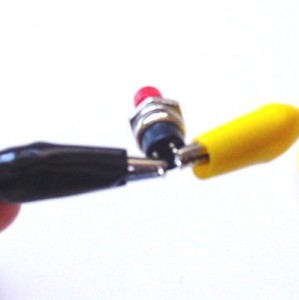 Make yourself a grab bag of fun things to test: copper pieces (nails or pipe pieces), zinc washers, pipe cleaners, Mylar, aluminum foil, pennies, nickels, keys, film canisters, paper clips, load stones (magnetic rock), other rocks, and just about anything else in the back of your desk drawer.
Make yourself a grab bag of fun things to test: copper pieces (nails or pipe pieces), zinc washers, pipe cleaners, Mylar, aluminum foil, pennies, nickels, keys, film canisters, paper clips, load stones (magnetic rock), other rocks, and just about anything else in the back of your desk drawer.
Certain materials conduct electricity better than others. Silver, for example, is one of the best electrical conductors on the planet, followed closely by copper and gold. Most scientists use gold contacts because, unlike silver and copper, gold does not tarnish (oxidize) as easily. Gold is a soft metal and wears away much more easily than others, but since most circuits are built for the short term (less than 50 years of use), the loss of material is unnoticeable.
[am4show have=’p8;p9;p20;p47;p76;p97;p58;’ guest_error=’Guest error message’ user_error=’User error message’ ]
Modify your basic LED circuit into a Conductivity Circuit by removing one clip lead from the battery and inserting a third clip lead to the battery terminal. The two free ends are your new clips to put things in from the grab bag. Try zippers, metal buttons, barrettes, water from a fountain, the fountain itself, bike racks, locks, doorknobs, unpainted benches… you get the idea!
Here’s what you need:
- 2 AA batteries
- AA battery case
- 3 alligator wires
- LEDs (any you choose is fine)
- paper clip
- penny
- other metal objects around your house (zippers, chairs, etc…)
Why does metal conduct electricity?
Why does metal, not plastic, conduct electricity? Imagine you have a garden hose with water flowing through it. The hose is like the metal wire, and the water is like the electric current. Trying to run electricity through plastic is like filling your hose with cement. It’s just the nature of the material.
Download Student Worksheet & Exercises
Exercises
- Name six materials that are electrically conductive.
- What kinds of materials are conductors and insulators?
- Can you convert an insulator into a conductor? How?
- Name four instances when insulators are a bad idea to have around.
- When are insulators essential to have?
[/am4show]
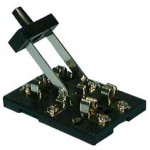 When you turn on a switch, it’s difficult to really see what’s going on… which is why we make our own from paperclips, brass fasteners, and index cards.
When you turn on a switch, it’s difficult to really see what’s going on… which is why we make our own from paperclips, brass fasteners, and index cards.
Kids can see the circuit on both sides of the card, so it makes sense why it works (especially after doing ‘Conductivity Testers’).
SPST stands for Single Pole, Single Throw, which means that the switch turns on only one circuit at a time. This is a great switch for one of the robots we’ll be making soon, as it only needs one motor to turn on and off.
[am4show have=’p8;p9;p20;p47;p106;p108;p97;p58;’ guest_error=’Guest error message’ user_error=’User error message’ ]
Think of this switch like a train track. When you throw the switches one way, the train (electrons) can race around the track at top speed. When you turn the switch to the OFF position, it’s like a bridge collapse for the train – there’s no way for the electrons to jump across from the brass fastener to the paper clip. When you switch it to the ON position (both sides), you’ve rebuilt the bridges for the train (electrons).
Troubleshooting: The two tabs on the back of the motor are the places to clip in the power from the battery pack. Since these motors spin quickly and the shaft is tiny, add a piece of tape to the shaft to see the spinning action more clearly.
Kids can make their own switches so they can trace the path the electricity takes with a finger. See what you think about this SPST:
Here’s what you need:
- 2 AA batteries
- AA battery case
- 3 alligator wires
- index card
- 2 brass fasteners
- paper clips
- buzzer, motor, or LED
Download Student Worksheet & Exercises
Exercises
- If you want to reverse the spin direction of a motor without using a switch, what can you do?
- A simple switch can be made out of what kinds of materials?
- How would you make your SPST switch an NC (normally closed) switch?
- How did you have to connect your circuit in order for both the LED and motor to work at the same time? Draw it here:
- Draw a picture of your experiment that explains how the SPST switch works, and show how electricity flows through your circuit:
Extra Credit (for students who have completed Part 3):
- Draw a picture of your experiment that explains how the DPDT switch works in your circuit and show how to wire up the circuit.
[/am4show]
Imagine you have two magnets. Glue one magnet on an imaginary record player (or a ‘lazy susan’ turntable) and hold the other magnet in your hand. What happens when you bring your hand close to the turntable magnet and bring the north sides together?
The magnet should repel and move, and since it’s on a turntable, it will circle out of the way. Now flip your hand over so you have the south facing the turntable. Notice how the turntable magnet is attracted to yours and rotates toward your hand. Just as it reaches your hand, flip it again to reveal the north side. Now the glued turntable magnet pushes away into another circle as you flip your magnet over again to attract it back to you. Imagine if you could time this well enough to get the turntable magnet to make a complete circle over and over again… that’s how a motor works!
After you get the buzzer and the light or LED to work, try spinning a DC motor:
[am4show have=’p8;p9;p20;p47;p106;p76;p97;p58;’ guest_error=’Guest error message’ user_error=’User error message’ ]
Here’s what you need:
- 2 AA batteries
- AA battery case
- 2 alligator wires
- 1.5-3V DC motor
- optional: propeller
[/am4show]
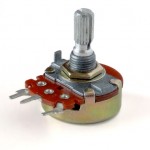 So now you know how to hook up a motor, and even wire it up to a switch so that it goes in forward and reverse. But what if you want to change speeds? This nifty electrical component will help you do just that.
So now you know how to hook up a motor, and even wire it up to a switch so that it goes in forward and reverse. But what if you want to change speeds? This nifty electrical component will help you do just that.
Once you understand how to use this potentiometer in a circuit, you’ll be able to control the speed of your laser light show motors as well as the motors and lights on your robots. Ready?
[am4show have=’p8;p9;p20;p47;p106;p108;p76;p97;p58;’ guest_error=’Guest error message’ user_error=’User error message’ ]
Here’s what you need:
- 2 AA batteries
- AA battery case
- 3 alligator wires
- potentiometer
- 1.5-3V DC motor
- LED (any you choose)
Download Student Worksheet & Exercises
Exercises
- How does a potentiometer work?
- Does the potentiometer work differently on the LED and the motor?
- Name three places you’ve used potentiometers in everyday life.
- How do you think you might wire up an LED, switch, and potentiometer?
[/am4show]
 Once you’ve made a a simple switch, you’re ready to use more advanced electrical components, such as the DPDT switch you picked up from an electronics store (refer to shopping list for this section). When you wire up this nifty device, you’ll be able to get your motors to go forward, reverse, and stop… all with the flip of a switch.
Once you’ve made a a simple switch, you’re ready to use more advanced electrical components, such as the DPDT switch you picked up from an electronics store (refer to shopping list for this section). When you wire up this nifty device, you’ll be able to get your motors to go forward, reverse, and stop… all with the flip of a switch.
You can use this component along with a potentiometer so you can not only control the direction but also the speed of a motor, like in a robot or laser light show. And don’t feel limited on using this switch just with motors – it works with bi-polar LEDs and other things as well. For example, you can hook this up so that when it’s in the UP position, the buzzer sounds, and the DOWN position makes the headlights go on. Are you ready to learn how to wire this one up?
[am4show have=’p8;p9;p20;p47;p106;p108;p97;’ guest_error=’Guest error message’ user_error=’User error message’ ]
Click here to learn how to incorporate this switch into your robot by making a simple remote control.
[/am4show]
You can use the idea that like charges repel (like two electrons) and opposites attract to move stuff around, stick to walls, float, spin, and roll. Make sure you do this experiment first.
I’ve got two different videos that use positive and negative charges to make things rotate, the first of which is more of a demonstration (unless you happen to have a 50,000 Volt electrostatic generator on hand), and the second is a homemade version on a smaller scale.
Did you know that you can make a motor turn using static electricity? Here’s how:
[am4show have=’p8;p9;p20;p47;p76;p97;p58;’ guest_error=’Guest error message’ user_error=’User error message’ ]
Download Student Worksheet & Exercises
Here’s how the electrostatic machine works – you will need:
- a yardstick
- spoon
- balloon
How does it work? Different parts of the atom have different electrical charges. The proton has a positive charge, the neutron has no charge (neutron, neutral get it?) and the electron has a negative charge. These charges repel and attract one another kind of like magnets repel or attract. Like charges repel (push away) one another and unlike charges attract one another.
So if two items that are both negatively charged get close to one another, the two items will try to get away from one another. If two items are both positively charged, they will try to get away from one another. If one item is positive and the other negative, they will try to come together.
How do things get charged? Generally things are neutrally charged. They aren’t very positive or negative. However, occasionally (or on purpose as we’ll see later) things can gain a charge. Things get charged when electrons move. Electrons are negatively charged particles. So if an object has more electrons than it usually does, that object would have a negative charge. If an object has less electrons than protons (positive charges), it would have a positive charge.
How do electrons move? It turns out that electrons can be kind of loosey-goosey. Depending on the type of atom they are a part of, they are quite willing to jump ship and go somewhere else. The way to get them to jump ship is to rub things together.
Remember, in static electricity, electrons are negatively charged and they can move from one object to another. This movement of electrons can create a positive charge (if something has too few electrons) or a negative charge (if something has too many electrons). It turns out that electrons will also move around inside an object without necessarily leaving the object. When this happens the object is said to have a temporary charge.
Try this: Blow up a balloon. When you rub the balloon on your head, the balloon is now filled up with extra electrons, and now has a negative charge. Now stick it to a wall— to create a temporary charge on a wall.
Opposite charges attract right? So, is the entire wall now an opposite charge from the balloon? No. In fact, the wall is not charged at all. It is neutral. So why did the balloon stick to it?
The balloon is negatively charged. It created a temporary positive charge when it got close to the wall. As the balloon gets closer to the wall, it repels the electrons in the wall. The negatively charged electrons in the wall are repelled from the negatively charged electrons in the balloon.
Since the electrons are repelled, what is left behind? Positive charges. The section of wall that has had its electrons repelled is now left positively charged. The negatively charged balloon will now “stick” to the positively charged wall. The wall is temporarily charged because once you move the balloon away, the electrons will go back to where they were and there will no longer be a charge on that part of the wall.
This is why plastic wrap, Styrofoam packing popcorn, and socks right out of the dryer stick to things. All those things have charges and can create temporary charges on things they get close to.
Want to purchase an electrostatic machine? Here’s a link to the one used in the video called a Wimshurst Machine which makes sparks up to 4″ long. For younger kids, we recommend this fun hand-held, non-shocking electrostatic generator.
Exercises
- What happens if you rub the balloon on other things, like a wool sweater?
- If you position other people with charged balloons around the table, how long can you keep the yardstick going
- Can we see electrons?
- How do you get rid of extra electrons?
- Why do you think the yardstick moved?
- What would happen if you use both a positively charged object and a negatively charged object to make the yardstick move?
[/am4show]
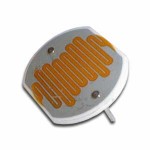 This is a super-cool and ultra-simple circuit experiment that shows you how a CdS (cadmium sulfide cell) works. A CdS cell is a special kind of resistor called a photoresistor, which is sensitive to light.
This is a super-cool and ultra-simple circuit experiment that shows you how a CdS (cadmium sulfide cell) works. A CdS cell is a special kind of resistor called a photoresistor, which is sensitive to light.
A resistor limits the amount of current (electricity) that flows through it, and since this one is light-sensitive, it will allow different amounts of current through depends on how much light it "sees".
Photoresistors are very inexpensive light detectors, and you'll find them in cameras, street lights, clock radios, robotics, and more. We're going to play with one and find out how to detect light using a simple series circuit.
Materials:
- AA battery case with batteries
- one CdS cell
- three alligator wires
- LED (any color and type)
[am4show have='p8;p9;p20;p47;p108;p76;p89;p97;p99;' guest_error='Guest error message' user_error='User error message' ]
Download Student Worksheet & Exercises
Turn this into a super-cool burglar alarm!
Exercises
- How is a CdS cell like a switch? How is it not like a switch?
- When is the LED the brightest?
- How could you use this as a burglar alarm?
[/am4show]
 This is a super-cool and ultra-simple circuit experiment that shows you how a CdS (cadmium sulfide cell) works. A CdS cell is a special kind of resistor called a photoresistor, which is sensitive to light.
This is a super-cool and ultra-simple circuit experiment that shows you how a CdS (cadmium sulfide cell) works. A CdS cell is a special kind of resistor called a photoresistor, which is sensitive to light.
A resistor limits the amount of current (electricity) that flows through it, and since this one is light-sensitive, it will allow different amounts of current through depends on how much light it "sees".
Photoresistors are very inexpensive light detectors, and you'll find them in cameras, street lights, clock radios, robotics, and more. We're going to play with one and find out how to detect light using a simple series circuit.
Materials:
- AA battery case with batteries
- one CdS cell
- three alligator wires
- LED (any color and type)
[am4show have='p8;p9;p20;p47;p108;p76;p89;p97;p99;' guest_error='Guest error message' user_error='User error message' ]
Download Student Worksheet & Exercises
Turn this into a super-cool burglar alarm!
Exercises
- How is a CdS cell like a switch? How is it not like a switch?
- When is the LED the brightest?
- How could you use this as a burglar alarm?
[/am4show]
 The smallest thing around is the atom, which has three main parts – the core (nucleus) houses the protons and neutrons, and the electron zips around in a cloud around the nucleus.
The smallest thing around is the atom, which has three main parts – the core (nucleus) houses the protons and neutrons, and the electron zips around in a cloud around the nucleus.
The proton has a positive charge, and the electron has a negative charge. In the hydrogen atom, which has one proton and one electron, the charges are balanced. If you steal the electron, you now have an unbalanced, positively charge atom and stuff really starts to happen. The flow of electrons is called electricity. We’re going to move electrons around and have them stick, not flow, so we call this ‘static electricity’.
These next experiments rely heavily on the idea that like charges repel and opposites attract. Your kids need to remember that these activities are all influenced by electrons, which are very small, easy to move around, and are invisible to the eye.
[am4show have=’p8;p9;p20;p47;p76;p97;’ guest_error=’Guest error message’ user_error=’User error message’ ]
Blow up a balloon. If you rub a balloon on your head, the balloon steals the electrons from your head, and now has a negative charge. Your head now has a positive charge because your head was electrically balanced (same number of positive and negative charges) until the balloon stole your negative electrons, leaving you with an unbalanced positive charge.
Let’ play with a more static electricity experiments, including making things move, roll, spin, chime, light up, wiggle and more using static electricity!
Here’s what you need:
- 7-9″ balloon (get two in case one pops)
- a wall
- wool sweater or scarf
- sink
- ping pong ball
- comb
- neon bulb
- tissue paper
- wire coat hanger
- tape
- packing peanuts
- bubble juice
- fluorescent bulb (burnt-out bulbs are fine to use)
- nylon stocking (AKA ‘panty-hose’)
- plastic grocery bag
Download Student Worksheet & Exercises
Static Electricity Experiments!
Expt. 1: Static Hairdo Charge a balloon by rubbing it on your head for 30 seconds. Pull the balloon up about six inches to check your progress – if the hair isn’t sticking to the balloon, try again on someone with clean, dry hair (without any hair styling goop). When you put the balloon close to your head, notice how your hair reaches out for the balloon. Your hair is positive, the balloon is negative, and you can see how they are attracted to each other!
Your hair stands up when you rub it with a balloon because your head is now positively charged, and all those plus charges don’t like each other (repel). They are trying to get as far away from each other as possible, so they spread far apart. Does the hair continue to stand apart even after you remove the balloon? Does it matter what hair color or texture? (Does the balloon shape matter?)
Bonus Question: How can you get rid of the extra electrons?
Expt. 2: Finding Attraction Rub your head with the balloon and then hold the balloon to a wall. Can you make it stick? How about the ceiling? How many other things does the balloon stick to? (Hint – try a wool sweater.)
Expt. 3 Wiggly Wonder Hold the charged balloon near a stream of water running from a faucet. Can you make the water wiggle without touching it? The charged balloon attracts the stream of water. The water is like a bar magnet in that there are poles on a water molecule: there’s a plus side and a minus side, and the water molecules line up their positive ends toward the balloon when you bring it close.
Expt. 4 Ping Pong Puzzle Rub a comb with a wool sweater, and bring it close to a ping pong ball resting on a flat table. Why do you think the ping pong ball moves? Does it work if you use a charged balloon instead? What if you swap the ping pong ball for a piece of styrofoam?
Expt. 5: Static Neon Store up a good charge of electrons by scuffing along the carpet in socks on a warm, dry day. To make this a much more interesting experiment, hold one end of a neon bulb and watch it light as you touch the other end to a nearby object such as a metal faucet, metal part of a lamp, etc. You can also bring it close to your TV set (the old tube TV kind), both turned on and just turned off, to see if it has any effects on the neon lamp bulb?
Hint: you’ll need to get the neon bulb out of the plastic encasing and hold only one of the wires to make this experiment work – one wire act a as the collector, the other is grounded (via your hand) to the earth. You can also hold onto one lead as you slide down a plastic slide and then touch something grounded (like your mom).
You steal electrons and take on a negative charge when you scuff along the carpet in socks. Remember that just like magnets, ‘like’ charges (negative-to-negative or positive-to-positive) repel, and opposite charges (negative-to-positive) attar, which is why you can make your hair stand up on end by scuffing around a lot. The hairs all become negative, trying to get as far away from each other as they can.
Expt. 6: Electric Tail Feathers Cut a sheet of tissue paper into 12 thin strips, about 1/2″ wide and 8-12″ long. Straighten out a wire coat hanger (snip off the hook part), or find yourself a 10g piece of metal uninsulated wire. Tape the strips to the end of a wire coat hanger (make sure your coat hanger do not have plastic insulation around it – use sandpaper to sand off any clear enamel if you’re not sure). Attach a piece of plastic with tape or clay to the center of the rod, making a V-groove so the handle sits better on the wire. Bring a very charged balloon near the end of the wire – what happens?
Expt. 7: Ghost Words (Although this experiment has also held the name “Ghost Poop”… ) Rub packing peanuts with wool or your hair to build up a strong, quick static charge. Stick the stryfoam to the wall to spell out words. How long do they stay attached to the wall? Does humidity matter? (Try spritzing with a light mist of water).
Expt. 8: Static Bubbles Blow a few big, round bubbles (use store-bought bubble solution, or make your own with 12 cups cold water and 1 cup clear Ivory dish soap and a wire coat hanger stretched into a diamond shape). Chase your bubbles with a charged balloon – what happens? Try the comb rubbed with wool – which works better? What other two things can you use to change the path of the soap bubble? (Photo: Tom Noddy, one of the greatest bubble magicians ever – he’s the first one to ever blow a square bubble.)
Expt. 9: Fluorescents Unplugged In a dark room, rub the length of a fluorescent bulb with a piece of plastic wrap (or polyethylene bag or wool sweater) vigorously and then pull your arm away – the bulb should light up momentarily. What other materials cause it to glow?
Expt. 10: Ghost Leg This experiment is absolutely hilarious to watch, but you must be persistent to get it right. On a cold winter day, crank up the heat in your house to warm and dry out the air. You now have the ideal static electricity environment. Take a nylon stocking (just a single knee-length will work, or just use half of a full pair, but roll up the unused half so it’s out of your way) and press the toe part against a nearby wall. Line your other hand with a piece of a clear plastic bag (if the plastic can stretch, it’s the right kind) and rub the nylon stocking vigorously. Now hold the stocking in the air and see if you scrubbed it well enough to charge the stocking with enough static charge so it repels itself and fills out – looking as if there’s a ghost filling out the leg!
Why do these experiments work?
The triboelectric series is a list that ranks different materials according to how they lose or gain electrons. Near the top of the list are materials that take on a positive charge, such as air, human skin, glass, rabbit fur, human hair, wool, silk, and aluminum. Near the bottom of the list are materials that take on a negative charge, such as amber, rubber balloons, copper, brass, gold, cellophane tape, Teflon, and silicone rubber.
When you rub a glass rod with silk, the glass takes on a positive charge and the silk holds the negative charge. When you rub your head with a balloon, the hair takes on a positive charge and the balloon takes on a negative charge.
When you scuff along the carpet, you build up a static charge (of electrons). Your socks insulate you from the ground, and the electrons can’t cross your sock-barrier and zip back into the ground. When you touch someone (or something grounded, like a metal faucet), the electrons jump from you and complete the circuit, sending the electrons from you to them (or it).
The fluorescent bulb lights up when the electrons jump around. The inside of the bulb is coated with phosphor (a white powder) and filled with mercury vapor gas. The phosphor gives off light whenever it gets smacked with UV light. The mercury vapor gives off UV light whenever it gets excited by electricity (movement of electrons). When you rub the outside of the bulb, electrons start to jump around, exciting the gas, which generated UV light, which hits the phosphor and causes it to glow briefly. When the bulb is in balance, it stays dark. If you tip the balance, electrons flow and you get light.
Exercises
- Why does the hair stick to the balloon?
- How do you get rid of electrons?
- Can you see electrons? Why or why not?
- Does it matter what kind of hair you rub the balloon on?
- How long does the hair continue to stand up after you remove the balloon?
- Does it matter what kind of balloon you use?
- How fast or slow do you need to rub for the biggest charge on the balloon?
- Does hair color matter?
- This evening, find an article or story that describes how electricity improves our lives. Bring the article to school. If you bring in an article that no one else brings in, you get extra points.
[/am4show]

